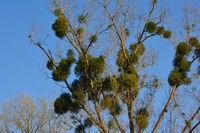Dakota Gardener: The origins of mistletoe kisses
(Click an image below to view a high-resolution image that can be downloaded)
By Esther E. McGinnis, Horticulturist
NDSU Extension
I have never been kissed under a sprig of mistletoe. However, mistletoe is prominently featured in Christmas songs such as Frank Sinatra’s "Mistletoe and Holly," "I Saw Mommy Kissing Santa Claus," and more recently Justin Bieber’s "Mistletoe." The magical world of Harry Potter isn't safe from mistletoe as the main character and Cho Chang learned. Is there an interesting origin story for this kiss-inducing plant or is this just a Hallmark Channel plot device?
Biologically, mistletoe is a less than romantic plant that parasitizes trees. Birds eat the berries and excrete the sticky seeds that adhere to branches. In fact, the word mistletoe is derived from the Anglo-Saxon words “mistel” and “tan” meaning dung-on-a- twig to signify the birds’ contributions. The seed germinates and penetrates the branch to absorb water and nutrients from the tree. Some mistletoe species develop leaves and can photosynthesize carbohydrates. Therefore, mistletoe doesn’t usually kill its tree host unless there are numerous parasitic plants.
While there is nothing to suggest a love story from its biology, mythology provides some tantalizing clues. Norse mythology tells of Baldur, the son of Odin and Frigg. Beloved by all, he has an omen that he is about to be killed. Desperate to protect him, Frigg extracts an oath from every living creature under or on the earth that they will not harm her son. Assuming that he was protected, the gods took turns throwing sharp objects at Balder. Each object harmlessly bounced off him. Loki, the god of mischief, tricked Frigg into revealing that she had failed to make mistletoe take an oath. She overlooked it because it was high in a tree. Loki then fashioned an arrow out of mistletoe and tricked Balder’s blind brother into shooting and killing him with the arrow. Many different accounts of this myth exist but none adequately explain why mistletoe became synonymous with stolen Christmas kisses.
Other cultures have embraced mistletoe. The ancient Greeks viewed it as a fertility symbol. Rome’s founding story in Virgil’s "Aeneid" links mistletoe to the sacred groves. The Druids celebrated an elaborate winter ritual of harvesting mistletoe. They most likely revered the bright green leaves and berries as a lifegiving force because they stood in bright contrast to bare, deciduous trees during winter.
The trail of mistletoe’s origin then goes cold for many centuries. In 1784, an English song was published that first refers to the tradition of men kissing young women under the mistletoe. Initially, this was a Christmas tradition among the servant class but quickly gained public acceptance.
As a horticulturist, I would be remiss if I didn’t pass along some practical knowledge. Worldwide, there are 1,300 species of mistletoe with over 40 species in the United States. The berries are an important food source for birds and provide nesting spots for spotted owls. Surprisingly, three species of hairstreak butterflies rely on mistletoe for food.
Enjoy mistletoe for its romantic and decorative purposes. Although birds eat mistletoe, humans and pets should not ingest any part of the plant.
NDSU Agriculture Communication – Dec. 4, 2024
Source: Esther McGinnis, 701-231-7406, esther.mcginnis@ndsu.edu
Editor: Kelli Anderson, 701-231-6136, kelli.c.anderson@ndsu.edu




